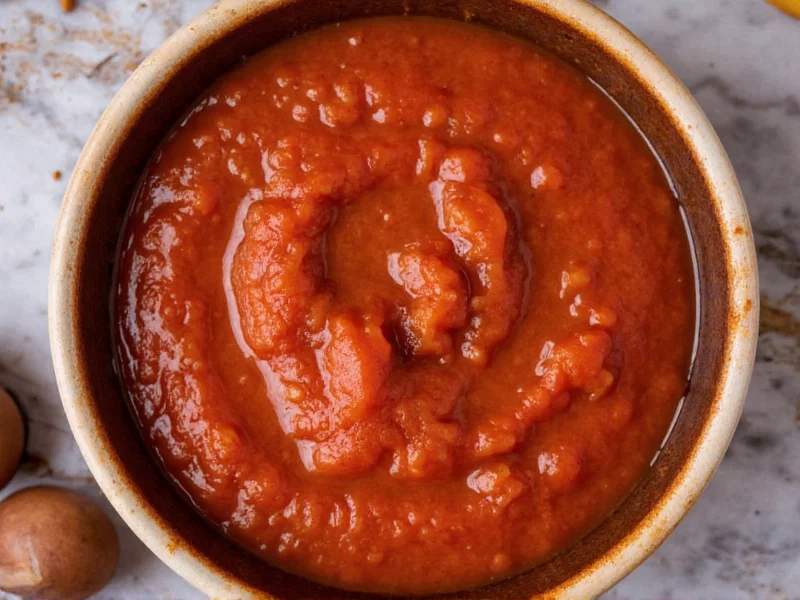Understanding Cuban sauce requires exploring its cultural roots and culinary applications. Unlike generic 'Cuban-style' sauces found in some restaurants outside Cuba, authentic mojo has specific ingredients and preparation methods passed down through generations. The distinctive flavor profile—tangy from citrus, pungent from garlic, and earthy from spices—creates the unmistakable taste associated with traditional Cuban dishes.
The Essential Components of Authentic Cuban Sauce
What makes Cuban sauce unique is its specific ingredient balance. While variations exist across regions and families, the core elements remain consistent. The traditional Cuban mojo sauce recipe relies on sour orange (naranja agria), which provides a distinctive bitter-sweet citrus note impossible to fully replicate with common orange varieties.
| Core Ingredient | Traditional Amount | Function |
|---|---|---|
| Sour orange juice | 1 cup | Provides distinctive tangy base |
| Fresh garlic | 6-8 cloves, minced | Creates signature pungent aroma |
| Olive oil | 1/4 cup | Carries flavors and creates emulsion |
| Cumin | 1 tsp, ground | Adds earthy depth |
| Oregano | 1 tsp, dried | Provides herbal note |
| Salt | To taste | Enhances all flavors |
Variations Across Cuban Culinary Traditions
Cuban sauce isn't a single standardized recipe but rather a family of sauces adapted to regional preferences and available ingredients. The most common variations include:
- Mojo Criollo—The classic version with sour orange, considered the foundation of Cuban pork dishes
- Mojo de Ajo—Garlic-forward variation with reduced citrus, popular in western Cuba
- Mojo Morado—"Purple mojo" made with purple onions, often used for yuca
- Mojo con Naranja Agria—Strictly traditional version using authentic sour oranges
When exploring authentic Cuban garlic sauce preparation, the technique matters as much as ingredients. Traditional preparation involves crushing garlic with salt using a mortar and pestle before adding other ingredients—a method that releases garlic's essential oils more effectively than chopping.
Substituting Sour Orange in Cuban Sauce Recipes
One of the biggest challenges for home cooks outside Cuba is obtaining genuine sour oranges. The authentic Cuban citrus marinade relies on this specific fruit, but suitable alternatives exist:
- Mix equal parts fresh orange juice and fresh lime juice
- Add 1 tablespoon white vinegar to regular orange juice
- Use tangelo or blood orange juice for similar complexity
While these substitutes won't perfectly replicate naranja agria, they create a respectable approximation of traditional Cuban restaurant-style sauce. The key is maintaining the proper acid balance—too little acidity makes the sauce flat, while too much overwhelms the garlic notes.
Traditional Applications of Cuban Sauce
Cuban sauce serves multiple functions in authentic cooking beyond simple condiment use:
- Marinade—Most famously for lechón asado (Cuban roast pork), where it penetrates the meat over 24-48 hours
- Dipping sauce—Served with boiled yuca (yuca con mojo), plantains, and other side dishes
- Cooking base—Used as the flavor foundation for many stews and braises
- Finishing sauce—Drizzled over completed dishes to add brightness
Understanding how to make Cuban citrus marinade properly reveals why it's so integral to the cuisine. The acid in the citrus begins breaking down meat fibers while the garlic and spices infuse flavor—creating tender, aromatic results impossible with milder marinades.
Preserving Authentic Flavor in Modern Kitchens
When preparing Cuban sauce at home, certain practices maintain authenticity while accommodating modern kitchens:
- Always use fresh garlic—pre-minced versions lack the enzymatic reactions that develop flavor
- Let the sauce rest for at least 2 hours before use to allow flavors to meld
- Store in glass containers—metal can react with citrus acids
- Freeze in ice cube trays for convenient portioning
The best Cuban sauce for roast pork requires patience—authentic preparation involves marinating the meat for a minimum of 24 hours, though 48 hours yields superior results. This extended marinating time allows the enzymes in the citrus and garlic to tenderize the meat while infusing it with complex flavors.
Common Misconceptions About Cuban Sauce
Several misunderstandings persist about Cuban sauce, particularly outside Cuba:
- Misconception: Cuban sauce is the same as mojo sauce from the Canary Islands
- Reality: While sharing origins, Cuban mojo has evolved distinctly with local ingredients and techniques
- Misconception: Any citrus-garlic sauce qualifies as authentic Cuban sauce
- Reality: The specific balance of sour orange, garlic, and spices defines authentic Cuban mojo
- Misconception: Cuban sauce must be spicy
- Reality: Traditional versions focus on citrus and garlic notes, not heat
Recognizing these distinctions helps preserve the integrity of this important culinary tradition while allowing for thoughtful adaptation based on ingredient availability.
Creating Your Own Cuban Sauce: Step-by-Step
Follow this authentic approach to make traditional Cuban sauce at home:
- Prepare 1 cup sour orange juice (or substitute mixture)
- Mince 6-8 garlic cloves and crush with 1 teaspoon salt using mortar and pestle
- Add 1 teaspoon ground cumin and 1 teaspoon dried oregano, continuing to crush
- Slowly whisk in 1/4 cup olive oil to create emulsion
- Add citrus juice and mix thoroughly
- Let rest at room temperature for 2 hours before use
This traditional Cuban garlic sauce recipe yields enough for marinating a 3-4 pound pork shoulder. For optimal results with Cuban mojo vs mojo criollo preparations, remember that the latter specifically refers to the Cuban adaptation of the original Canarian sauce.











 浙公网安备
33010002000092号
浙公网安备
33010002000092号 浙B2-20120091-4
浙B2-20120091-4